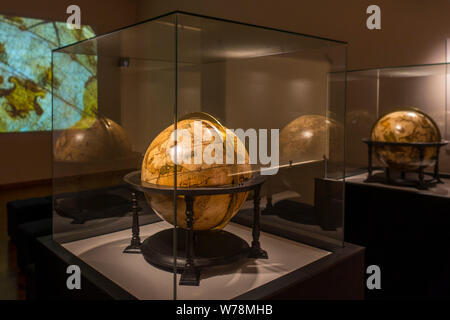
Title: Cosmographia: Charting the Renaissance Universe
Introduction
The term “Cosmographia” merges two ancient Greek terms—Kosmos (world or universe) and Graphia (writing or description)—to signify “a depiction of the world or universe.” More than merely a synonym for geography, Cosmographia signified an amalgamation of various fields, such as astronomy, geography, cartography, and navigation. Throughout the European Renaissance, a period marked by a resurgence in science and education, cosmographies thrived as intricate works aimed at portraying and elucidating the known universe. They became essential elements in the developing interplay between scientific inquiry, technological advancements, religious beliefs, and national identity.
This article delves into the progression of Cosmographia during the Renaissance, highlighting its prominent texts and figures, ultimately leading to the English classic, The Cosmographical Glasse by William Cuningham.
I. The Genesis and Developments of Cosmographia
The idea of Cosmographia arose as a more expansive counterpart to Geographia. While “Geographia” specifically addresses the physical configuration of Earth, “Cosmographia” not only includes terrestrial geography but also the celestial realms, uniting astronomy with earthly mapping. This dual emphasis was influenced by the Greco-Roman legacy, especially the works of Claudius Ptolemy, recognized for both his Geographike Hyphegesis and Almagest. Latin translations of Ptolemy’s texts during the Middle Ages and their resurgence in the Renaissance rekindled interest in the empirical exploration of the cosmos.
II. Renaissance Bestsellers: Apian and Münster
Cosmographia rose to prominence in the 16th century through lavishly illustrated and widely circulated compilations. Peter Apian (1495–1552), a German mathematician and cartographer, released his Cosmographicus liber in 1524 in Landshut. Merging theoretical astronomy with applied geography, Apian’s text achieved immense popularity, undergoing over 40 editions in five languages. After the initial edition, his student Gemma Frisius (1508–1555), a significant figure in Renaissance cartography, edited and published subsequent volumes.
Another pivotal cosmographer was Sebastian Münster (1488–1552), whose Cosmographia (1544) became one of the most published books of the 16th century. A richly illustrated tome detailing the known world, it facilitated the translation of geographical insights into the vernacular for an increasingly secular, literate public.
III. The Widening Landscape: Maurolico’s Cosmographia
Broadening the scope beyond Apian and Münster’s contributions was Francesco Maurolico (1494–1575), a Sicilian astronomer, mathematician, and philosopher. His Cosmographia Francisci Maurolyci Messanensis (1543), structured as a dialogue, concentrated on the forms, positions, and numbers of both terrestrial elements and celestial spheres. This contribution exemplified a heightened scientific rigor in cosmography and positioned him among the elite intellectuals of the Renaissance.
IV. The English Legacy: William Cuningham’s The Cosmographical Glasse
In 1559, England made its entry into the cosmographical scene with William Cuningham’s The Cosmographical Glasse, conteinyng the pleasant Principles of Cosmographie, Geographie, Hydrograhie, or Nauigation. Published by the Protestant printer John Daye, the book marked several firsts. It was the first English publication to introduce the apostrophe and employed the double-pica italic typeface designed by French punch cutter Françoise Guyot. Cuningham’s monumental work served as a thorough guide to the mathematical arts vital for mapping and navigation.
Cuningham, a physician and astrologer from Norwich, studied at Cambridge and traveled extensively during Queen Mary’s Catholic reign, completing his medical education in Heidelberg. His journeys acquainted him with the latest cosmographical knowledge, which he assimilated and refined for an English-speaking audience.
V. Framework and Substance of The Cosmographical Glasse
The book is organized into five sections, encompassing:
– Astronomy: A Ptolemaic, geocentric framework of the cosmos
– Geography: Covering knowledge of global coordinates and latitude
– Cartography: Techniques for map creation
– Navigation: Practical guidance on determining latitude and longitude
– Chorography: Detailed localized mapping, exemplified by Cuningham’s renowned map of Norwich
Cuningham’s text was delivered through Platonic dialogues between a teacher, Philonicus, and a student, Spoudaeus, rendering it accessible to readers in Elizabethan England while remaining rooted in classical sources such as Ptolemy, Aristotle, Proclus, and Strabo.
VI. Innovations and Impact
Although building upon earlier works, including uncredited excerpts from Maurolico, Cuningham offered noteworthy contributions:
– Introduction of triangulation techniques: Adapted from Gemma Frisius, Cuningham localized the surveying method with reference to Norfolk towns, though his version left out